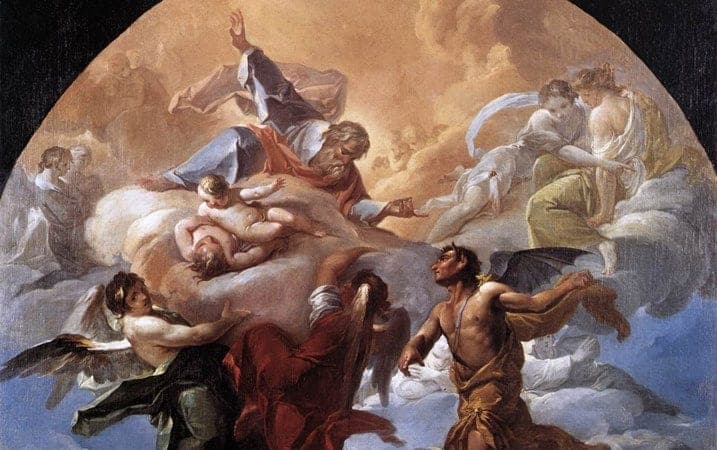When it comes to thinking about evil in our contemporary world, there are two mistakes we can make: to see it everywhere, to see it nowhere. C.S. Lewis warned of both extremes in his introduction to The Screwtape Letters.
There are two equal and opposite errors into which our race can fall about the devils. One is to disbelieve in their existence. The other is to believe, and to feel an excessive and unhealthy interest in them. They themselves are equally pleased by both errors and hail a materialist or a magician with the same delight.
Pope Francis seems to walk a razor’s edge between both extremes.
Indeed, for all of Pope Francis’ modern appeal, he seems hell bent on the reality of Satan. As the Rev. Thomas Rosica, a Vatican spokesman, writes at CNN, “Francis is dead serious about the devil! And he takes every opportunity he can to tell the devil to get the hell out of our lives and our world.”
“The devil also exists in the 21st century, and we need to learn from the Gospel how to battle against him,” the pontiff said last spring.
According to Rosica, all of Francis’ devil talk is less theological than it is “a call to arms, an invitation to immediate action, offering very concrete steps to do combat with the devil and the reign of evil in the world today.” Though “combat with the devil” sounds hopelessly archaic, Rosica says that Francis stresses that humans fight against Satan every day. Whenever we are tempted to negativity and despair, he says, that is such combat.
If you conclude that Francis sees the devil merely as a symbolic figure, you’d be wrong. “Paul tells us this, it’s not me saying it,” the pontiff preached last October. “The Word of God is telling us this. But we’re not all convinced of this.”
Maybe not all of us — but most are. From 1990 to 2007, the percentage of Americans who believe in Satan jumped from 55 to 70. Recently, the number has dropped a bit, but it remains the case that the majority of Americans believe in the devil.
Of course, the question is, what kind of devil do they believe in?
In the past two years in the US, we’ve seen a Black Mass at Harvard (which was canceled, then rescheduled, then moved off campus), a statue of Baphomet erected in Detroit, and a Satanist coloring book released by the Satanic Temple. In each of these instances, stagers and participants of the events defended their actions with a nod to free speech.
Take, for example, the Satanic Temple’s statement justifying their decision to disseminate a coloring book in Florida public schools. “If a public school board is going to allow religious pamphlets and full Bibles to be distributed to students,” said Lucien Greaves, spokesperson for the Satanic Temple, “we think the responsible thing to do is to ensure that these students are given access to a variety of differing religious opinions, as opposed to standing idly by while one religious voice dominates the discourse and delivers propaganda to youth.”
Satan, then, as opposed to a real-life character, becomes an archetype for rebellion, which is very much in line with a statement made by Anton Lavey, who founded the Church of Satan in 1966. Lavey made it clear that his church doesn’t worship Satan.
We worship ourselves using the metaphorical representation of the qualities of Satan. Satan is the name used by Judeo-Christians for that force of individuality and pride within us. But the force itself has been called by many names. … It so happens that we are living in a culture that is predominantly Judeo-Christian, so we emphasize Satan.
So on one hand, there does seem to be something to the idea that Americans look at Satan as more of a metaphorical figure rather than a character. But pop culture’s fascination with evil seems to go beyond that. In October alone, several films were released exploring the dark side, including “Crimson Peak,” “Paranormal Activity,” and “The Diabolical.” Evil doesn’t function metaphorically in these films.
Since the 1970s, words like “Satan” and “demons” and “exorcism” have called to mind certain cinematic images: most notably, horns and a pitchfork, or a shrieking girl crawling backwards up a wall, vomiting, cursing all that is holy.
According to Christian theology, says Chad Pecknold, associate professor of theology at Catholic University of America, “the devil continues to prowl about the world seeking the ruin of souls, continues to look for those souls, those houses, those nations, which do not have the mark of Passover upon them.”
Some priests believe Satan has upped his prowling in recent years — resulting in an increase of possessions.
“We are living in a particularly critical time in history, where urgency, superficiality, exasperated individualism, secularization seem to almost dominate our culture,” Valter Cascioli, spokesperson for the International Association of Exorcists (IAE), told Vatican Radio last year. “The battle against evil is becoming more of an emergency.”
This “emergency,” writes Crux’s Inés San Martín, is one reason why the Catholic Church has tried to boost its numbers of exorcists by offering an annual training course in Rome, titled “Exorcism and Prayers of Liberation.” It might also be an explanation for the IAE’s official recognition by Pope Francis in 2014. (The group was founded in 1993.)
John Thavis, author of “The Vatican Prophecies,” which explores contemporary supernatural claims, including demon possession, says that some priests who perform exorcisms are concerned that evil is not taken seriously today.
“Too many people in the modern world are naively going about [demon possession] thinking it’s kind of a joke,” he says, noting that many exorcists are very concerned about the modern spin Satan seems to be enjoying. “There seems to be an effort to turn the Devil into a kinder, gentler figure. And certain exorcists are aghast. They think this is a sign of the times in a bad way: a sign that our culture is really naive when it comes to evil.”
Thavis notes how easy it is to go online and join Satanic cults. “You can Google your favorite demon,” he adds, “and for some people it’s kind of a laugh — it’s not serious.” But for exorcists, he says, that behavior can lead to much more serious things, like possession. “These are modern portholes to demon possession, they say, and they claim to have cases to back it up.”
Thavis documents some of these cases in his book, but says, as a journalist, he remains skeptical about them. The tales he includes aren’t filled with the movie magic stuff of Hollywood, but they do contain certain details that would give any strict materialist pause: people speaking in languages they haven’t studied, rosary beads found ripped apart, children growling in deep voices.
According to Thomas John Paprocki, bishop of the Diocese of Springfield, IL, common signs of being possessed by demons include “speaking a number of words in an unknown language or understanding someone speaking in a language that the possessed person has never studied, making known distant and hidden events, and showing strength beyond the nature of the individual’s age or condition.” He cautions that these signs “do not necessarily offer conclusive proof of possession, so it is also necessary to pay attention to other things” — for example, whether or not the alleged possessed shows “vehement aversion to God, the name of Jesus,” or holy objects.
Perhaps because many of the signs associated with possession could be explained without recourse to the supernatural, many priests, including higher-ups in the Vatican, say that most claims of possession are probably mental health issues. For that reason, priests are advised to ensure the alleged possessed have been thoroughly examined by mental health workers.
The Church has always taught that possession happens — but that it happens rarely. In a statement to Crux, IAE said that demonic possession is an extraordinary action of the devil, which is less frequent than the ordinary one: temptation.
Monsignor John Esseff of the Diocese of Scranton, Pa., an exorcist for more than 40 years, told National Catholic Register that while possessions are rare — he’s only seen two — the devil is also capable of oppressing and obsessing people.
In fact, says Thavis, this is how Francis talks about devil — “as a figure who leads people into bad habits, and moral compromise. He is a manipulator, so be attentive and resist!” You might not be climbing backwards up walls, says Francis, but that gossip you just listened to? That was the devil’s work.
“Everybody looks at possession from a special effect level,” says the Rev. Steve Grunow of Word on Fire, “and I suppose that’s in the realm of possibility.” But Satan’s work, he says, is more mundane than it appears on film.
“I think within each person is a ‘No’ to God, to his will and purpose — a ‘No’ to Christ. If that ‘No’ becomes the way in which we operate in the world, always out of this grim will and purpose — that’s what possession looks like. A ‘No’ in the face of the demand of love. That’s how devil gets in.”















